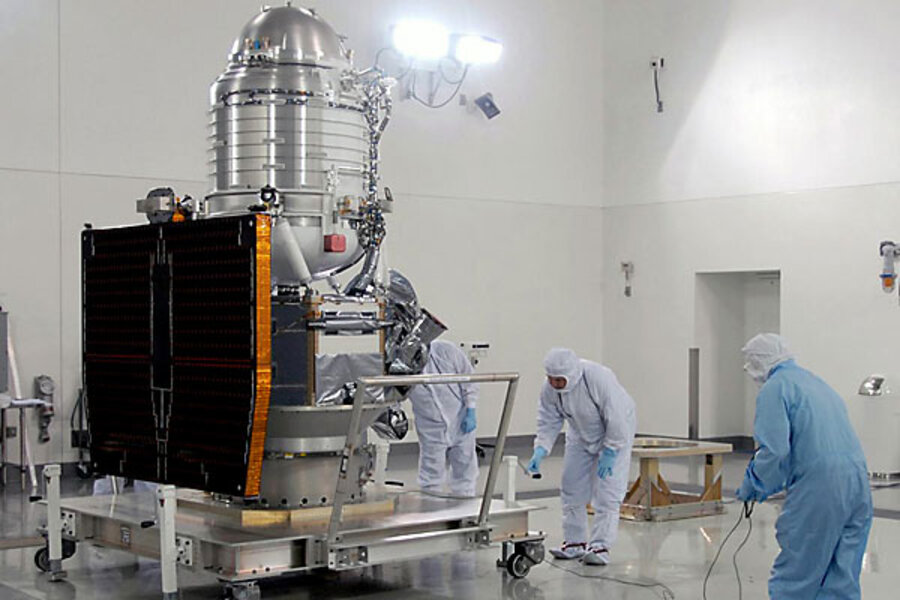WISE set to search for universe's hidden 'dark' objects
Early Monday morning, after two delays, NASA is scheduled to launch an unmanned orbiting observatory that promises to greatly enhance, and significantly change, humanity's understanding of the heavens.
The Wide-field Infrared Survey Explorer (WISE) is expected to launch from Vandenberg Air Force Base near Santa Barbara, Calif., between 9:09 and 9:23 a.m. Eastern time. From its eventual orbit 325 miles above earth, it will begin a blitz of picture-taking with equipment of unprecedented sensitivity. WISE will map the heavens on four infrared channels, frequencies of long-wave radiation that are invisible to the human eye and many telescopes.
The end-product of the 10-month mission will be a publicly available catalog of photos that, once stitched together and processed, will offer a portrait of the whole sky in unequaled crispness and detail.
"It really is going to be our GPS [Global Positioning System] for astronomers," says Amy Mainzer, WISE deputy project scientist, from the launch site at the Vandenberg Air Force Base near Santa Barbara, Calif. "No matter what you like, we'll have something for you."
Seeing 'dark' celestial bodies
Looking at long-wave radiation offers several advantages compared with viewing just the visible light spectrum – the colors of the rainbow. All matter does not reflect light, nor do all stars emit it. Some asteroids are blacker than coal, and some young solar systems and galaxies are shrouded in light-blocking dust. Certain small stars, the so-called brown dwarfs, aren't quite massive enough to ignite a nuclear reaction. These "failed stars" emit heat, but no light.
All of these "dark" celestial bodies are invisible to standard telescopes.
But unless matter is at a temperature of absolute zero – an impossibility in a universe containing other energetic things, say scientists – it always emits heat. So scientists liken the launch of WISE to donning a very powerful pair of night-vision goggles. And once the goggles are in place, they expect to discover celestial bodies in many now seemingly empty areas of the sky.
After all, WISE is hundreds of times more powerful than its predecessor, the Infrared Astronomical Satellite, which was launched in 1983.
Brown dwarfs, colliding galaxies, and more
WISE's sensors will pick up dark – and potentially threatening – near-Earth objects, like asteroids. The satellite will see the rings of dust around young stars that scientists think eventually build into planets like ours. Colliding galaxies, which are shrouded in dust, will also be visible. And brown dwarfs, which are thought to be more numerous than light-emitting stars in our galaxy, will be revealed.
Many researchers suspect that we have brown dwarf neighbors closer than Alpha Centauri, which, at 4.37 light years away, is usually considered the star nearest the Sun.
"It will be completing the census of these cold objects in the solar neighborhood," says Jonathan Fortney, assistant professor of astronomy and astrophysics at the University of California at Santa Cruz, who is not involved with the mission. "We'll finally know what our solar neighborhood looks like."
One million pictures
Once in orbit – and after a systems-test phase – the 10-foot tall WISE will begin snapping pictures every 11 seconds. Armed with a 4 megapixel sensor, WISE will take more than 1 million photos during its mission.
"Having a list of objects from something like WISE provides you with ... targets” to look at more closely, says Marcia Rieke, a professor of astronomy at the University of Arizona in Tucson. As principal investigator on the James Webb Space Telescope, scheduled for launch in 2014, she plans to do just that.
Without the information from WISE, "there's no big sign post in space saying, 'Look here,' " Dr. Rieke says.
WISE's pictures of near-earth objects and minor planets will be immediately available as they're taken. The entire WISE catalog, part of which will be released during the mission, is slated for public release in 2011. Who knows what WISE will reveal.
"We're exploring the universe in a new way, and we're sure to find surprises," says Dr. Mainzer of the WISE team. "In fact, one thing I'm sure of is that I'm sure to be surprised."
-----
Follow us on Twitter.





